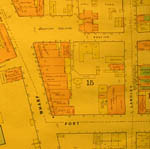 |
 |
 |
 |
 |
 |
 |
The main offences which the police had to deal with were mainly drunk and disorderly persons, assaults, deserters and vagrancy cases. Impaired driving and the impaired driving of horse and wagon were common offenses as well . As Augustus Pemberton served a magistrate of the Victoria police court, he focused his crime fighting efforts on petty criminals who particularly were thieves, drunks, street fighters and deserting sailors. In the early 1860s, the majority of those who migrated to Victoria were transient, were deemed poor in character, and the majority of their activities often involved the consumption of alcohol. At times in the decade, there were over 100 saloons in Victoria where alcohol was sold. Petitions were signed to ban the sale of alcohol, however many were against the idea, claiming that everyone had the right to liquor that was easily and readily available. In 1860, however, there was a law put in practice prohibiting the sale or trading of liquor to Aboriginals. The law however proved ineffective, as the majority of cases had only testimonies and this often was not sufficient enough to charge someone who sold liquor to the Natives. Because of the lack of enforcement, many illegally sold liquor to Aboriginals and it became a highly profitable business. For many, however, this was a victimless crime and it was not a concern to many provided the Natives who were drunk remained on their reserves. Often when they did cause a disturbance, it was not worthy of anything more than a visit from the police. Often the only time police and citizens were concerned of the Aboriginals’ behavior was when they did something which would affect the white person’s life in a direct way. These instances would include stealing, prostitution, or murder and these things were dealt with in a serious manner. Drinking was just as big a part of the settlers’ lives as it was the Natives; however when it came to drinking problems, their behavior was not viewed as problematic as the natives. In reality, the settlers drinking practices were no different than that of the Aboriginals, but the temperance law was drawn out along the lines of race due to the paternalistic view that the colonial administration had towards the Native peoples. Whereas the drink problems of the transient miners could be at least tolerated, Natives were largely condemned for their behaviour. Another major issue that rose up from largely transient male population was the widespread prostitution that occurred. Much like liquor, this issue was racialized as well, with Natives and the Chinese in particular being blamed for the problem, this despite the fact that the majority of clients were white and many of the cases of prostitution were in white persons’ establishments . It was difficult for prostitution to be controlled. The city at the time simply saw prostitution as a nuisance and creating filth to the cities buildings. A bylaw was put into place dealing with suppressing the housing of the ill fame that generally ensured that minimal health conditions needed to be met on properties. Prostitution offenses were often not big enough to warrant criminal offenses, rather they were treated as breaking a bylaw and violators were fined minimally . --------------------------------------------------------------------------------------------------------------------- Documents
--------------------------------------------------------------------------------------------------------------------- |